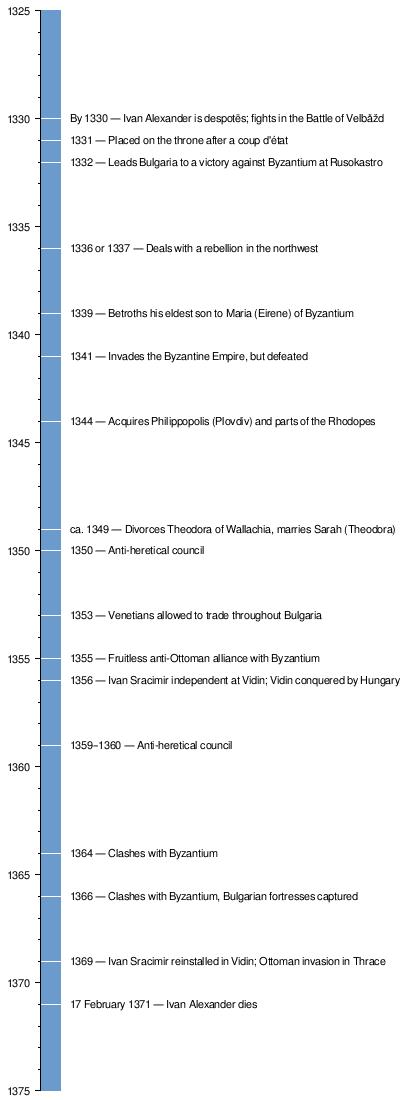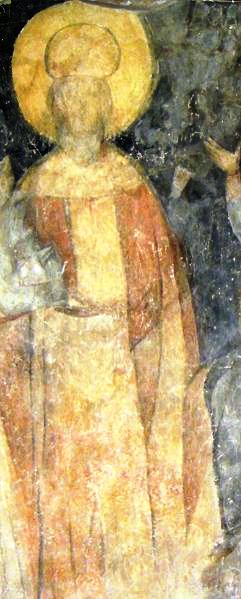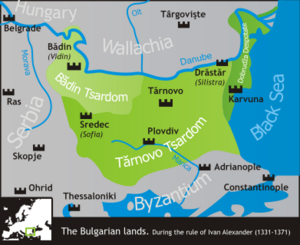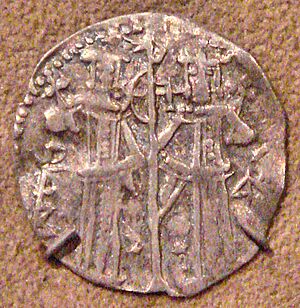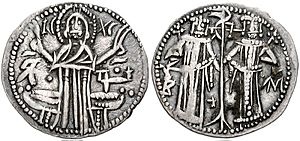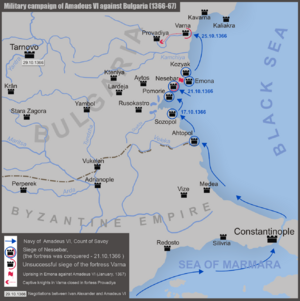Ivan Alexander of Bulgaria facts for kids
Quick facts for kids Ivan Alexander |
|
|---|---|
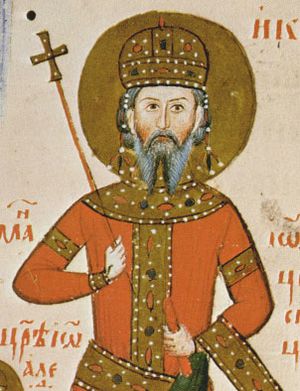
Portrait of the tsar from the medieval manuscript, Tetraevangelia of Ivan Alexander
|
|
| Tsar of Bulgaria | |
| Reign | 1331 – 17 February 1371 |
| Predecessor | Ivan Stephen |
| Successor | Ivan Shishman Ivan Sratsimir |
| Died | 17 February 1371 |
| Spouse | Theodora of Wallachia Sarah (Theodora) |
| Issue | see below |
| Dynasty | Sratsimir |
| Father | Sratsimir |
| Mother | Keratsa Petritsa |
| Religion | Eastern Orthodox |
Ivan Alexander was a powerful ruler of Bulgaria during the Second Bulgarian Empire. He was the Emperor (or Tsar) of Bulgaria from 1331 to 1371. We don't know exactly when he was born, but he died on February 17, 1371.
Ivan Alexander's long rule was a time of big changes for Bulgaria. He started by fixing problems inside the country and dealing with threats from neighbors like the Byzantine Empire and Serbia. He also helped Bulgaria's economy grow and brought back a period of great culture and religion. This time is sometimes called the "Second Golden Age of Bulgarian culture."
However, later in his rule, Ivan Alexander faced new challenges. The Ottoman Empire started invading, and there were attacks from Hungary in the northwest. The terrible disease known as the Black Death also hit the country. To try and solve these problems, he made a difficult decision. He divided Bulgaria between his two sons. This made the country weaker and split, which made it harder to fight off the coming Ottoman invasion.
Contents
Starting His Rule
Ivan Alexander was the son of a noble named Sracimir. His mother, Petrica, was the sister of a previous Bulgarian Emperor, Michael Asen III. This meant Ivan Alexander was Michael Asen III's nephew. By 1330, Ivan Alexander was already a regional governor in the city of Lovech.
In 1330, Ivan Alexander fought in a battle against the Serbs, where Bulgaria lost. This defeat, along with problems with the Byzantine Empire, caused trouble inside Bulgaria. In 1331, a sudden change in power happened. The previous emperor, Ivan Stefan, was removed from the capital city of Tarnovo, and Ivan Alexander became the new ruler.
The new emperor quickly worked to make his position strong. He wanted to get back lands that Bulgaria had recently lost to the Byzantine Empire. In 1331, Ivan Alexander led a military campaign near Adrianople and took back parts of northeastern Thrace.
Around the same time, the Serbian king was also replaced. This helped make relations between Bulgaria and Serbia better. Ivan Alexander and the new Serbian king made an alliance. They sealed this alliance with a marriage: Ivan Alexander's sister, Helena of Bulgaria, married the Serbian king in 1332.
Nobody of our first tsars seems to us like this great tsar Ivan Alexander, in his military power he looks to us like a second ancient Alexander the Great, in faith and piety he is a second Saint Constantine; he captured thus all his enemies, put them under his knees and established firm peace in the Universe.
In 1332, the Byzantine Emperor Andronikos III Palaiologos attacked Bulgaria. Ivan Alexander quickly moved his army south and met Andronikos III at Rusokastro. Ivan Alexander made it seem like he wanted to talk, but then his army, helped by Mongol horsemen, attacked. They defeated the Byzantine army in the Battle of Rusokastro. The cities that had been taken by the Byzantines then surrendered to Ivan Alexander.
The war ended with Ivan Alexander and Andronikos agreeing to peace. To make their alliance stronger, Ivan Alexander's oldest son, Michael Asen IV, was promised to Andronikos's daughter. They married in 1339.
Around 1332, Ivan Alexander made his oldest son, Michael Asen IV, a co-emperor. This was a way to make sure his family would keep the throne. He later made his younger sons, Ivan Sracimir and Ivan Asen IV, co-emperors in 1337. Ivan Alexander might have done this to control important cities and regions better. For example, Ivan Sracimir was based in Vidin.
Dealing with the Byzantine Empire
In the early 1340s, relations with the Byzantine Empire became difficult again. Ivan Alexander demanded that his cousin, Šišman, be sent back to Bulgaria. He threatened war if his demand was not met. However, this plan did not work. The Byzantines saw through his threat and sent their allies, Turkish forces, to attack Bulgaria. These forces landed near the Danube River, raided the countryside, and attacked Bulgarian cities.
Ivan Alexander had to back down from his demands. He invaded the Byzantine Empire again in late 1341, saying that the people of Adrianople had asked for his help. But Ivan Alexander's troops were defeated twice by the Turkish allies of the Byzantines near the city.
From 1341 to 1347, the Byzantine Empire was in a long civil war. Ivan Alexander supported one side, while the Serbian king supported the other. Even though they were on opposite sides in the Byzantine civil war, Bulgaria and Serbia remained allies. As a reward for Ivan Alexander's support, the Byzantines gave him the city of Philippopolis (Plovdiv) and nine important fortresses in the Rhodope Mountains in 1344. This was Ivan Alexander's last big success in foreign policy.
Rise of the Ottoman Threat
During this time, the Serbian king took advantage of the Byzantine civil war. He took control of much of what is now Macedonia, Albania, and northern Greece. In 1345, he started calling himself "Emperor of Serbs and Greeks." Bulgaria supported these actions.
By the late 1340s, Ivan Alexander's early successes were fading. Turkish allies of the Byzantines raided parts of Bulgarian Thrace many times between 1346 and 1354. On top of this, the Black Death caused great damage. Bulgaria tried to fight off the invaders but failed many times. Ivan Alexander's third son, Ivan Asen IV, was killed fighting the Turks in 1349. His older brother, Michael Asen IV, also died in battle against the Turks around 1355.
By 1351, the Byzantine civil war was over. The Byzantine emperor realized how dangerous the Ottomans were to the Balkan Peninsula. He asked the rulers of Serbia and Bulgaria to join forces against the Turks. He even asked Ivan Alexander for money to build warships. But his neighbors did not trust him, and his requests were ignored.
Another attempt for Bulgaria and the Byzantine Empire to work together happened in 1355. To make the agreement stronger, Ivan Alexander's daughter, Keraca Marija, married a future Byzantine Emperor. But this alliance did not lead to any real results.
More Problems and Conflicts
At home, Ivan Alexander created problems for his country's stability. He divorced his first wife around 1349 and married a Jewish woman named Theodora. This new marriage brought new sons, and Ivan Alexander made them co-emperors too. Ivan Šišman became co-emperor around 1356, and Ivan Asen V by 1359.
Ivan Sracimir, Ivan Alexander's last surviving son from his first marriage, became almost completely independent around 1356. Ivan Alexander also had less control over other powerful local rulers, like those in Wallachia and Dobruja, who started making their own foreign policies.
In the mid-14th century, Bulgaria also faced attacks from the Hungarian king, Louis I of Hungary. He took over Moldavia in 1352 and then conquered Vidin in 1365. He even captured Ivan Sracimir and his family.
In 1364, Bulgarians and Byzantines fought again. In 1366, when the Byzantine Emperor was returning from a trip, the Bulgarians refused to let him pass through their country. This decision backfired. Another Byzantine ally, Count Amadeus VI, Count of Savoy, attacked several Bulgarian cities by the sea, including Pomorie and Nesebǎr. He did not manage to take Varna.
Ivan Alexander was forced to make peace. The captured cities were given to the Byzantine Empire. The Byzantine Emperor paid Ivan Alexander 180,000 florins. Ivan Alexander used this money and land deals to convince his local rulers, Dobrotica of Dobruja and Vladislav I of Wallachia, to help him take Vidin back from the Hungarians. The war was successful, and Ivan Sracimir was put back in charge of Vidin in 1369. However, the Hungarian king made him agree to be under his rule.
Even though the problems in the northwest were solved, the losses in the southeast continued. To make things worse, around 1369, the Ottoman Turks under Murad I conquered Adrianople (which they had taken in 1363) and made it their new capital. At the same time, they also captured the Bulgarian cities of Philippopolis and Stara Zagora.
As Bulgaria and the Serbian princes prepared to fight the Turks together, Ivan Alexander died on February 17, 1371. His sons, Ivan Sracimir in Vidin and Ivan Shishman in Tarnovo, took over. The rulers of Dobruja and Wallachia became even more independent.
Culture and Religion
During Ivan Alexander's rule, the Second Bulgarian Empire had a great time of cultural growth. Many Bulgarian monasteries and churches were built or fixed because Ivan Alexander ordered it. You can still see paintings of him as a donor (someone who gives money) in the Bachkovo Monastery and the Rock-hewn Churches of Ivanovo.
Many important books and writings were also created during his reign. These include a translation of the Manasses Chronicle (1344–1345), the beautifully illustrated Tetraevangelia of Ivan Alexander (1355–1356), the Tomić Psalter (1360), and the Sofia Psalter (1337).
Ivan Alexander also worked to make the Bulgarian Orthodox Church stronger. He held two church councils, in 1350 and 1359–1360, to condemn different religious groups that were seen as heretics.
The practice of hesychasm, a type of prayer, became very important in the Eastern Orthodox Church during this time. A famous Bulgarian follower of this movement during Ivan Alexander's rule was Theodosius of Tǎrnovo.
During this period, the Bulgarian Empire traded with powerful cities around the Mediterranean Sea, like Venice, Genoa, and Ragusa. In 1353, Ivan Alexander gave permission for Venetian merchants to trade freely in Bulgaria.
In modern times, Ivan Alexander's rule inspired the famous Bulgarian writer Ivan Vazov to write a short novel and a play about the tsar.
A piece of clothing signed by Ivan Alexander and woven with gold was found in a noble's grave in the 1970s. It is now kept in the National Museum of Serbia. This shows a medieval tradition where Orthodox rulers would give pieces of their clothing to important people.
Ivan Alexander Point on Nelson Island in Antarctica is named after Ivan Alexander of Bulgaria.
Family
With his first wife Theodora of Wallachia, he had:
- Tsar Ivan Sratsimir of Bulgaria (born 1324/1328 – died 1394), who became Emperor of Bulgaria after his father.
- Prince Michail Asen (around 1322–1355), a Bulgarian Prince.
- Prince Ivan Asen IV (1326 – 1349).
With his second wife Sarah-Theodora, Ivan Alexander had several other children:
- Princess Kera Tamara (1340 – 1389); she first married Despot Constantine and later became a concubine of Sultan Murad I of the Ottoman Empire.
- Tsar Ivan Shishman of Bulgaria (1350 – June 3, 1395).
- Princess Desislava of Bulgaria.
- Prince Ivan Asen V of Bulgaria (died 1388).
- Princess Keratsa of Bulgaria (1348 – 1390), who married Byzantine Emperor Andronikos IV Palaiologos and had a son.
- Princess Vasilisa of Bulgaria.
| Sracimir of Krǎn | Petrica | ||||||||
| 1 | 2 | ||||||||
| Theodora of Wallachia | Ivan Alexander (d. 1371, ruled 1331–1371) |
Sarah (Theodora) | |||||||
| 1 | 1 | 1 | 1 | 2 | 2 | 2 | 2 | 2 | |
| Michael Asen IV | Thamar (Kera Tamara) | Ivan Šišman (b. 1350–1351, d. 1395, ruled 1371–1395) |
Ivan Asen V | Vasilisa | |||||
| Ivan Asen IV | Ivan Sracimir (b. c. 1324, d. c. 1397, ruled 1356–1397) |
Keraca Marija (b. 1348, d. 1390) |
Desislava | ||||||
Timeline
